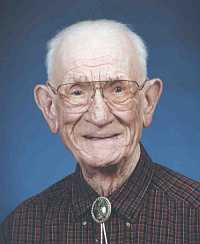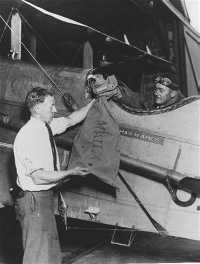
|
|
|
NEWSLETTERS -- WINTER 1999 Page 2
John Lunsford responded by mail then we talked on the phone. In the conversation, I learned that the 96-year-old Air Mail Pioneer remembers the early days of the Air Mail Service as if they were yesterday. Lunsford, who spent 50 years in aviation, 29 of it as an FAA safety inspector, calls himself the last of the Mohegans for airmail information. "I learned my subject well and was in demand." Although his physical health is not great, when I spoke to him his mind was as active and as sharp as ever. He recalled the turmoil of searching for overdue pilot Charlie Ames. The date was October 1, 1925; the weather en route to Cleveland that night was miserable. By 11:30 p.m. Ames had failed to reach Bellefonte field in Pennsylvania. Ten days later, after an extensive search in which Lunsford took part -- he recalls landing in corn fields "almost killing ourselves" -- a ground party found Ames four miles west of Bellefonte. Ames, who had died on impact, had flown directly into a mountain. A happier memory for Lunsford was the time Steve Kaufman’s airplane landed in the mountains in the trees. Steve walked up the road to a farm house where he persuaded the farmer to drive him to the nearby post office; afterwards he returned home and Lunsford assumed salvage duty. As was standard procedure, he recovered all the usable parts of the plane and then burned it. "Steve was a wonderful fellow," said Lunsford.
"I knew Shirley Short real well," he said. "He went with the Chicago Times and was killed in their corporation plane. It came apart and wasn’t engineered right. "Bill Williams [Warren D (Bill) Williams flew for the service from 8-10-20 to 9-3-27] was my old buddy." Lunsford fondly tells the story of the time Bill Williams, flying a new Douglas M4, got lost in the clouds, couldn’t figure out what the plane was doing [cause was icing], panicked and jumped. "When he broke out at the base of the clouds, he saw the airplane circling him. He was in the middle of a tight circle. He didn’t get hurt, but I went out and picked him up and brought the airplane back to the base and we destroyed everything except I saved the propeller. I made him a desk set out of the metal propeller. I took a big piece of mahogany and laid it in there and engraved the airmail route on this metal part of the prop clear across from Hadley Field to San Francisco, and then where he jumped out I put a parachute coming down. "The Cleveland Plain Dealer wrote an article about his jumping and my spending three years making him a trophy. Then the newsman decided I ought to put the trophy in the newspaper’s display window down in Cleveland. It was a beautiful thing. Bill went on to be chief pilot for United, retired and died, and I went to his funeral. He’d put in thousand of hours with United." Editor’s note: During a visit to Cheyenne I had time to drive over to Denver and visit Air Mail Pioneer Jack LaFollette who lives by himself in a small apartment. At the age of 16 Jack LaFollette, now 90-years-old, was a mere sprite when he worked for the Air Mail Service. His father, Warren E. "Dad" LaFollette -- a field manager from December 1918 to June 1927-- got him a job as a field clerk for the Salt Lake City to San Francisco run. "I was the goat," remembers Jack LaFollette. "I had to get up at 4:00 a.m. and get the mail that was going east. It worked satisfactorily. I didn’t have to wait for the plane to take off. I just unloaded the mail and went back to sleep." In Salt Lake City he would sit on top of the hangar roof and watch for the plane coming over the mountain. "Western Union would notify us that the plane was coming. It was important to get that mail transferred and have a plane warmed up in time before the in-coming plane came over the mountain." LaFollette recalls that part of his duties included opening and re-folding parachutes. In a long narrow building with a big table he and others would periodically re-fold parachutes. "Every month we unpacked about six or seven then packed them up again. We grabbed the top chute, which was the last thing folded over. That small chute then snapped the rest of them out. It had springs in it like an umbrella. When we’d unpack it, it would open up. It would open up and pull the main parachute out for about 30 feet in diameter. Somebody in Washington made the decision to re-pack them. Then someone told us that he had packed them in good and tight and not to unpack them." He remembers his dad as an excellent mechanic who never had a formal education but was a born mechanic. "He could put anything together." Dad LaFollette set up airfields across the country for the Air Mail Service. "He was an organizer and troubleshooter," says his son. His father was involved in establishing beacons for night flying. "He went down the line and pounded spikes in the ground where the beacons should go." As a teen, full of spice and vinegar, LaFollette recalls the time he and some field hand buddies about his age got up on the roof of the Salt Lake City hangar with a bucket of rocks. While the station workers below were eating lunch they poured the rocks down the stove pipe. "They ran out of there like scared rabbits. Then we had to sit up there in the heat all afternoon. There were quite a bunch of young fellows working for the Air Mail Service; they were good friends of mine. When my father died about 15 or 18 came, some of them from quite far off -- Chicago and Cleveland -- some of them still working for whatever airlines took over the airmail routes." |
History |
Air Mail Pilots
|
Photo
Gallery |
Flight Info
|
Antique Airplanes
|
Members |
|
copyright © 1999 Nancy Allison Wright, President Air Mail Pioneers
|


